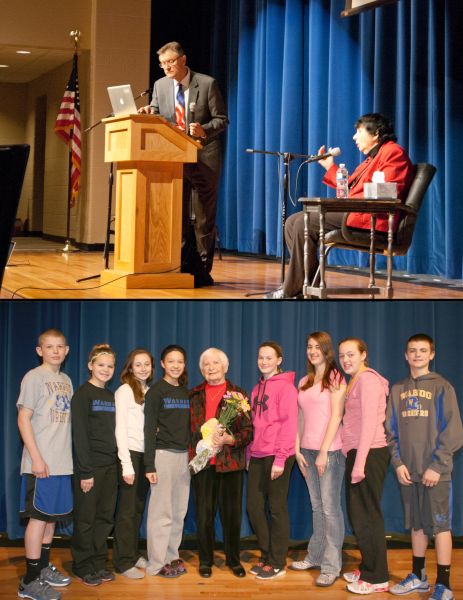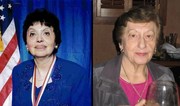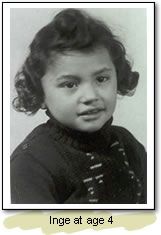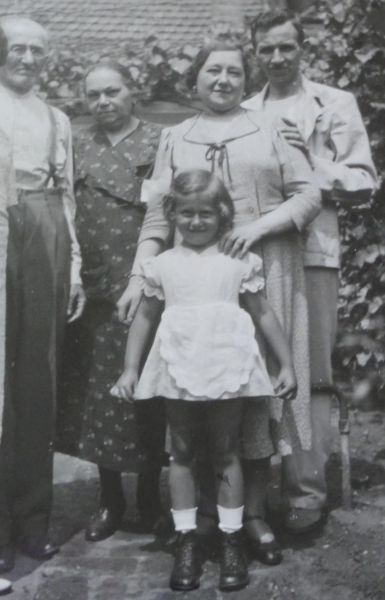2,200+ Nebraska Students Experience Holocaust History First-Hand, from Survivors
Assembly Videos Posted
For the second straight year, Wahoo High School was honored to work with the Institute for Holocaust Education (IHE) and Educational Service Unit #2 in Fremont to host Holocaust survivors Inge Auerbacher (from New York) and Kitty Williams (from Council Bluffs, IA) in two separate assemblies on Wednesday, March 6, 2013 (Chicago native Agnes Schwartz was originally scheduled for the afternoon session, but was delayed at the airport due to weather conditions).
These events were scheduled as part of the observance of A Week of Understanding 2013, giving our students and community members the opportunity to experience this dark period of history first-hand from those who lived it. Auerbacher and Williams presented powerful messages which promoted peace and illustrated the ability to overcome unimaginable adversity. It is also their mission to do everything they can to make sure the atrocities of the Holocaust are never repeated.
Auerbacher spoke in a morning session from 10:00-11:30 a.m., and Williams spoke in the afternoon from 1:30-3:00 p.m. Overall, 37 schools participated in the assemblies (17 in the audience, and 25 live via a distance learning connection), reaching over 2,200 students from across the state--Nebraska City to Chadron! Many community members from Wahoo and the surrounding area also attended.
Inge Auerbacher
Kitty Williams
Media Coverage:
Please click HERE to read the Omaha World-Herald's coverage of the 2013 Holocaust Survivor assemblies.
From the Wahoo Newspaper:
Students have brush with history in Wahoo
By Kris Byars and Kelsi Martin
WAHOO – Inge Auerbacher was just a child when her family first started feeling the effects of Adolf Hitler’s rise to power.
Auerbacher’s father had fought for Germany in World War I, sustaining an injury to his arm that left him permanently disabled. He received the Iron Cross, an honor similar to the Purple Heart, and was proud to have served his country.
“We were very proud German citizens,” she said.
Auerbacher said that, before Hitler came to power, Christians and Jews lived comfortably side-by-side in her hometown of Kippenheim, a community situated in southern Germany near the Black Forest.
“The Christians went to church on Sunday and our Sabbath was on Saturday,” she recalled. “Outside of that, there was no difference.”
During the two presentations given Wednesday at Wahoo High School, the auditorium was so silent, one could hear a pin drop, in spite of the hundreds of students that filled the seats.
The two women, Auerbacher of Jamaica, N.Y. and Kitty Williams of Council Bluffs, Iowa, were both holocaust survivors. On Wednesday, they shared their first hand accounts with schools from throughout southeast Nebraska.
Wahoo Public High School hosted in the event, and five schools sent students to watch the presentations in person, while another 12 participated through the use of distance learning technology.
According to Wahoo High School Superintendent Galen Boldt, it was a unique opportunity that the district was more than willing to share with as many as possible.
“It is not often we get to hear someone who has lived history,” he stated.
There was only one doctor in town when Auerbacher was born. He delivered her in the same house where members of her family had been born for more than 100 years.
“The doctor himself was actually a member of the Nazi Party,” she said. “But he took very good care of us.”
As the Third Reich consolidated power, however, conditions began to deteriorate.
Though only a child at the time, Auerbacher can recall standing in a Jewish shop following the infamous Kristalnacht in 1938, remembered in English speaking countries as “the night of broken glass.” Over the course of two nights, Nov. 9 and 10, 1938, the windows of shops and businesses owned by Jewish citizens were shattered.
Auerbacher also recalls when her village’s Synagogue was desecrated.
“Our holy scrolls were torn apart,” she said.
After Auerbacher’s father was temporarily shipped off to Dachau, her world started to fall apart.
In 1940, Jews started being deported from Kippenheim. By then, she and her parents had sold their home and moved in with their grandparents.
By 1941, however, the Reich caught up with them and Auerbacher’s grandmother was shipped to Riga, where she was among the 50,000 to 80,000 people who were shot and buried in mass graves. Had it not been for a letter written by Auerbacher’s father regarding his service in World War I, she and her parents would also have been buried in one of those graves.
By August of 1942, however, her family was out of options. They were transported to Theresienstadt, a Czech concentration camp. There she would spend the next three years.
Conditions were terrible. Auerbacher said there was never enough food, and sickness was rampant. Conditions were particularly bad for the children, and only one percent of the children that went into the camps came out again.
Auerbacher wasn’t the only survivor to share her story on Wednesday.
Williams, the youngest of six children, stated that her family was the only Jewish family in their Hungarian town.
“We were accepted in town as equal,” she said.
Her father was a decorated soldier in the Hungarian military.
Germany invaded Hungary on March 22, 1944 and Williams’ family started to feel the tension that was growing between the Germans and the Jews.
“They started to put restrictions on Jews,” she explained. “From then on, our life changed.”
The Germans required men aged 15 to 45 to report to the army, and they were taken away to labor camps.
It was during this time that Williams suffered the loss of her brother and brother-in-law.
“Eventually, we were put in ghettos,” she added. “The soldiers were so brutal.”
People were only allowed one suitcase and food was scarce, she said.
When Williams was 19 years old, German soldiers appeared at her father’s door one evening. Her father convinced the soldiers that she wasn’t in the house while she hid terrified underneath the bed.
“Once I was arrested because I was on the street and my jacket covered my yellow star,” she added.
A friend was able to bribe the guards into letting her free.
“To this day, I don’t know how she bribed the officers,” she said.
Williams stated that she is very thankful for those who were willing to befriend her despite the serious consequences if caught.
“Any little thing you did for a Jew, death was sure if you were caught,” she explained.
Conditions got continually worse, and Williams eventually found herself in Auschwitz concentration camp.
Although the quarters in which she was housed were built for 500 people, Williams was one of 1,000 people in her building.
“There was no flooring,” she said. “We slept on the dirt floor.”
There was not enough food given to the prisoners, she added.
“Not enough to live on, but enough not to die,” she explained. “It kept us going.”
She described the horrors of the camp with dead bodies, the stench of burning flesh and the ear piercing screams of the suffering.
Williams was eventually transported to a munitions factory, where she and other Jewish women were required to remake bombs that had not exploded in the field.
She recalled how their hair and skin began to turn yellow from inhaling poison during the course of their work.
A few months later, with the arrival of American troops, they were liberated.
“We were very fortunate to survive Auschwitz. It was a miracle,” she said. “Not very many survived. If you didn’t die in the gas chambers, you died of starvation or were beat to death.”
Both Auerbacher and Williams said they felt it was important to tell their stories to the students.
“About 2009, I decided it was time to speak about it,” said Williams. “I realized that this is the only way you will learn about it."
“There are 11 million people who can’t speak for themselves. I speak for them.”
In addition to giving live presentations, Auerbacher has shared her story through books and songs that she has written. Her book, “I am a Star” has been translated into eight languages.
Williams wants young people in America to understand that everyone deserves to be treated the same, no matter how different they may seem.
“It’s hard to imagine that innocent people were killed because they were different,” she noted. “It’s up to you, young people, to make sure it doesn’t happen again.”
Auerbacher said that the thing she wants students to take away is that it’s important to stand up to injustices, wherever one finds them.
“There were so many people there who saw what was going on but did nothing,” she said. “If you are a bystander and you witness these atrocities but do nothing, you are guilty too.”
These messages were definitely received.
“It gives me chills, thinking about what they went through, and that people just stood by and watched,” said Cedar Bluffs High School Junior Mikayla Rhodes.
Cedar Bluffs Freshman Cody Cozed said he was humbled by the fact that, throughout all of the bad things that happened to her and her family, Auerbacher was able to keep her faith.
“That’s inspiring to me,” he said.
The students also took away a deeper appreciation for their own lives.
“It makes me feel really great for what I have,” said Wahoo High School Student Mallory Lindstrom.
“It makes you want to embrace everything and live like it’s your last breath,” agreed Wahoo High School Student Carleigh Olson.
Preview Article:
Holocaust Survivors Tell Their Stories, March 6 at WHS
2,000 students from 37 Nebraska schools will be among the last generation to hear from a survivor in-person
by Joan Wilson, Educational Service Unit #2 - Fremont
The Institute for Holocaust Education, Educational Service Units 2 and 17, and Wahoo Public Schools are pleased to partner together in the interest of Holocaust education to give nearly 2,000 students statewide the opportunity to visit with Holocaust survivors.
Thirteen (13) schools will bring students to Wahoo on March 6, while an additional 24 schools -- from as far west as Chadron to as far east as Nebraska City -- will participate through video teleconferencing technology.
"These students will be the last generation to hear from a survivor in-person," said IHE spokesperson Laura Stastny.
Two Holocaust survivors, who at the time were children, will recount their personal experiences during 90-minute presentations, with the final 30 minutes of each session for Q&A from school audiences:
Child Survivor Inge Auerbacher, presently living in New York City, will tell her story during a morning presentation from 10:00 to 11:30 a.m.
Child Survivor Agnes Schwartz, presently living in Chicago, will tell her story during an afternoon presentation from 1:30 to 3:00 p.m.
Both presentations will be held in the WPS Performance-Learning Center.
Said Stastny: "One of the most profound ways to learn about the Holocaust is to hear a first-hand account from a Holocaust survivor. Those who present their stories not only testify to the extent of the Holocaust, but they also provide a human face to the facts and figures that may often seem impersonal. Survivor testimony is a significant way to reinforce the lessons you are already teaching in the classroom."
About Inge Auerbacher (please click HERE to visit her website)
Holocaust Survivor, Author and Inspirational Speaker
Inge was born in Germany and spent three childhood years, between 7-10 years of age, in the Terezin (Theresienstadt) concentration camp in Czechoslovakia, where out of 15,000 children, only about 1 percent survived.
Inge and her parents were deported from Germany to Czechoslovakia in August, 1942. Terezin was selected by the Nazis as a transit camp before inmates were to be deported to killing center further East, like Auschwitz. After three long years, liberation came by the Soviet Army on May 8, 1945.
Miraculously, Inge and both her parents survived. Inge and her parents immigrated to America in May, 1946.
She was silent about her war experiences until 1981 when she began writing and lecturing on the Holocaust. She tells her life story in three books: I am a Star: Child of the Holocaust, Beyond the Yellow Star to America, and Finding Dr. Schatz - The Discovery of Streptomycin and A Life It Saved.
A film for middle school children, "The Olympic Doll," is based on her book I Am A Star and is a lesson about tolerance.
She has been awarded the following prestigious awards for her work teaching tolerance and human rights:
* Ellis Island Medal of Honor - 1999
* Louis E. Yavner Citizen Award - 1999
* Doctor of Humane Letters honoris causa, Long Island University - 2005
About Agnes Schwartz (Please click HERE for read additional information)
Holocaust Survivor
Born in Budapest July 24, 1933, Agnes lived in a ‘well to do’ family as an only child growing up during the Second World War. Though her family was Jewish, Agnes attended a girls Catholic school.
When the Germans invaded Hungary in March 1944, her grandparents were moved into Budapest and soon her entire family was forced to wear the Yellow Star. They were moved from their apartment into a Jewish Designated Building (ghetto) and crammed into a dirty apartment.
Agnes's father lost his business and she could no longer attend school. In November of 1944, a group of Nazi officers came to their building and ordered all men 18 to 45 to line up outside. Her father was taken away, and she had no idea if she would ever see him again. Later in the month, the Nazis came and took away all of the women in that same age group.
At 10 years old, the family's former maid (Julia Balazs) took Agnes in as her "niece" who was fleeing from the Russian army. During Allied bombings, Agnes was sent underground to hide for months.
Agnes's grandmother, grandfather, and aunt were drowned in the Danube. Her mother perished at Bergen-Belsen concentration camp.
Agnes' father was saved by Raoul Wallenberg and hid in one of his safe houses. In January 1947, reunited, Agnes and her father left for Chicago. However, within a year her father returned to Hungary, leaving Agnes in the care of an aunt.
Agnes still lives in the Chicago area.




 Launch the media gallery 2 player
Launch the media gallery 2 player Launch the media gallery 3 player
Launch the media gallery 3 player